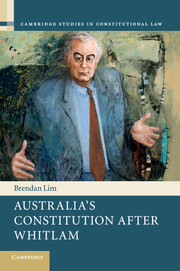Foreword
Published online by Cambridge University Press: 06 April 2017
Summary
‘One indissoluble Federal Commonwealth under the Crown’ – that is how the preamble to the Commonwealth of Australia Constitution Act 1900 (Imp) described the polity called into existence by the agreement of the Australian ‘people’ in what the Commonwealth of Australia Constitution Act went on formally to enact as the Australian Constitution. The first sentence of the preamble in that way captured not only the creative and sustaining notion of popular sovereignty but also the hybrid nature of the singular entity that is the Commonwealth of Australia.
The Commonwealth of Australia is at once both federal and under the Crown. It is federal in the late-eighteenth century – let us say Madisonian – sense that it allocates power between branches of government along the lines of the written Constitution of the United States. It is under the Crown in the late-nineteenth century – let us say Diceyan – sense that it concentrates power in the popularly elected legislative branch along the lines of the unwritten constitution of the United Kingdom.
It was an event which occurred late in the twentieth century which brought that dual character into its sharpest relief. The dismissal of the government of Gough Whitlam by the Governor-General, Sir John Kerr, at 1.15 pm on 11 November 1975 was on any view a momentous event in Australian constitutional history. To some it epitomised the folly of the entire constitutional endeavour that was the Washminster mutation. To others it represented the triumph of one form of constitutionalism, and the betrayal of another. To others again it was an aberration: a momentary breakdown in a marriage of opposites which had otherwise shown itself in practice to be harmonious and stable.
As portrayed by Brendan Lim in this book, the dismissal was none of those things. The dismissal appears as the climax of an episode of high drama in a continuing story of informal constitutional change. The dismissal was the culmination of innate tensions between systemic forces epitomised, rather than precipitated, by the personalities of the principal protagonists: on the one hand, Whitlam the Diceyan, the ‘monist’, the populist and to the end the idealist; on the other hand, Kerr the Madisonian, the ‘dualist’, the legalist and at the end the pragmatist.
- Type
- Chapter
- Information
- Australia's Constitution after Whitlam , pp. xi - xiiPublisher: Cambridge University PressPrint publication year: 2017

